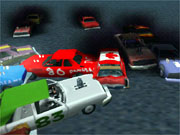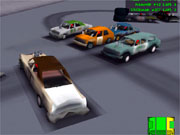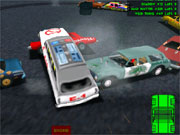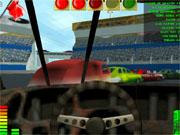There's something to be said for small development studios. However, for every indie game that ends up being a surprise hit, there are a half dozen other games that prove just how difficult it is to devise and construct a product that lives up to today's high standards. Unfortunately, eGames' Demolition Derby and Figure 8 Race is an example of the latter category. The first release from Michigan-based Auxiliary Power, Demolition Derby highlights arguably the most exciting part of motorized competition--crashing--and smartly rewards accuracy and sheer aggressiveness. Unfortunately, the game looks and feels so rudimentary that you can't help but wonder if you're playing a prerelease beta version. Even at its budget-conscious sub-$20 MSRP, Demolition Derby isn't all it could or should have been.

Admittedly, the arena of metallic carnage that is the demolition derby has not gotten a fair shake in the world of PC entertainment. In fact, apart from Psygnosis' thrilling late-1990s Destruction Derby series, Demolition Derby may be the only other game of any consequence to address this wonderfully accident-happy brand of motorsport. But even Psygnosis' very first Destruction Derby game, released way back in 1996, offered more visceral excitement, more depth, and more graphical goodies than this. Demolition Derby is a strangely subdued affair that tends to make even the most horrific head-on collision seem bland.
Right from the start, Demolition Derby seems startlingly mediocre. The opening sequence features a surprisingly primitive splash screen, some of the most bizarre music you may ever hear in a driving game, and a series of animated driving sequences of such poor quality that you can only hope they aren't indicative of the gameplay. Worse still, you may not even get that far. We experienced several crashes (not the good kind where two cars collide, but the bad kind where the game drops you to the Windows desktop) during our test period, many of which arose just as we tried to launch the game. The program booted us at other times too--most often between events as it attempted to load a new track. For some reason, we were able to get past most of these crashes by waiting a few moments before hitting the start button after we'd chosen our vehicle.
Even if you're fortunate enough to not experience a lot of Demolition Derby's technical problems, you'll soon see that it's quite simply a notch or two below most other driving games currently on the market. Perhaps most curious is its obvious lack of prerace preparation and user-customization options. After you sign in, you'll select a 640x480, 800x600, or 1024x768 screen resolution, choose one of three global graphic detail settings, and settle on one of three driver perspectives. Further visual tweaking is not permitted. You'll then adjust the game's three audio options and decide on one of four difficulty settings. Other than choosing your preferred car and track, that's pretty much it. In Demolition Derby, there is no track editor, vehicle customization shop, parts and upgrades store, or garage. You can't select a season or championship mode, and you can't choose the number of drivers you'll compete with. Even the game's "trophy case," which displays some of your achievements but certainly not all, looks pieced together from the evaluation version of a simple graphics painting program. Yes, it's that bad.
When you do head for the car and track selection screen, the game takes a slight turn for the better. To its credit, developer Auxiliary Power has provided several dozen automobiles of differing sizes and shapes, running the gamut from subcompacts to station wagons and even a hearse. Some are substantially slower and more durable, while others are speedier and more geared toward the decreased damage potential of a figure-eight race than the pile-driving antics of a full-blown demo derby. In fact, since some cars will be finished after just a single good hit, making the correct selection is essential. Yet none of them are licensed representations of real-world cars, and none of them are accompanied by any sort of statistics. You'll actually have to drive each and every vehicle to know what does what.

Likewise, the game's venues don't have any statistical information. Of the nearly two-dozen circuits offered, the vast majority are oval or rectangular bullrings with few distinguishing features. Three are figure-eight courses. However, unlike Destruction Derby's figure eights, the Demolition Derby figure eights aren't bordered by colorful walls that define a predetermined route. Instead, the developer has simply placed an oil drums at both ends of an otherwise wide-open arena. You'll steer to the right around the first drum and then zip on down to the other end of the arena, where you'll steer to the left around the next.
It's this freewheeling design that makes Demolition Derby figure-eight racing temporarily enjoyable. It's a lot of fun, actually, planning just how wide or tight to take the next turn based upon how many kamikaze drivers are going to nail you as they cross your path in the middle of the circuit. Soon, your car is flying around, trying to avoid others while at the same time attempting to spin a rival driver off course, or even better, attempting to smash into another car and turn it on its side or completely upside down on its roof. The game's computer-controlled drivers don't have the same advantage you do--a hotkey that lets you magically right yourself--so flipping some AI drivers may well end their day. Unless they get nudged again, which may cause them to flip back over, right side up. Judging when to initiate contact and when to stay clear is an entertaining pastime until you realize that even at the highest difficulty settings, winning a figure-eight race is pretty straightforward. Once you've won the game's five-minute figure-eight events at the game's highest difficulty setting, there's little more to do except to move on to the demo derby.
The demo derby mode is perhaps the most disappointing part of the game. Whereas Psygnosis' Destruction Derby featured hugely deformable vehicles, flying chassis chunks, wild speed bursts, and cataclysmic crash audio, Demolition Derby sports none of the above. The pace is slow and calming, the acceleration is plodding (particularly in reverse gear, where you'll need a few seconds just to get the wheels rolling), and the crash effects are distinctly underwhelming. Granted, cars will deform to reflect the degree of damage they've sustained, but it happens so slowly and so subtly that you really can't see the damage appear. Steam and thick black smoke rise from battered engines, but both are completely opaque and therefore will obscure your view of the immediate surroundings. Unfortunately, parts, tires, and wheels don't detach and bounce about, either.

From a purely visual standpoint, Demolition Derby isn't particularly inspiring. Looking like a refugee from the mid-1990s, the game is hampered by indistinct object outlines, grainy textures, and cute but decidedly primitive automobiles. Trackside scenery is confined to a spectator-filled grandstand, distant trees and mountains, and precious few extras. The actual racing surfaces are flat, dreary palettes.
The game's audio is just as unimpressive. Although your own engine emits a tolerable growl that varies as you accelerate, the sounds from the vehicles around you are strangely inconsistent. The crash effects are repetitive and strikingly similar to the sound of a soda can being crushed. There are no announcers and no decipherable cheering spectators, and you certainly won't hear anything from the totally mute drivers. Post- and prerace music is a strange mixture of brass and country and therefore seems oddly out of place.
Thankfully, Auxiliary Power has created a flock of intelligent AI drivers. Make no mistake--these guys know where you are and are perfectly capable of applying a thorough beating. One of your options is to become a constantly weaving moving target, steering clear of contact and relatively free of blemishes, although such actions will elicit a warning and eventual banishment from the invisible authorities. An infinitely better alternative is to watch and absorb the game's informative yet rather dull slideshow tutorial, where you'll learn that belting a guy on his front or back end will damage your own car as much as it will his. You'll also learn that a wheel well is a great pace to attack, second only to a door. It is a welcome bonus that Demolition Derby accentuates the accuracy of an attack more than its force. Unfortunately, it doesn't keep tabs of the number of hits you've scored, instead rewarding you only for the amount of time you've managed to keep your engine running.

However, the unremarkable special effects and sluggish pace--the latter of which often results in a mishmash clump of cars slowly trying to extricate themselves from one another--isn't the only reason the demo derby component isn't all it could be. Almost as annoying are the intangibles infused into the top two difficulty levels. Rather than adding fiercer competition, longer events, or more challenging venues, the game's higher difficulty levels force you to drive an increasingly delicate automobile. Indeed, your car becomes so fragile at the most demanding difficulty setting that even a rear-end impact can destroy your front-mounted engine! And that simply isn't fair.
Though it does show some promise and may be intriguing enough to keep young or inexperienced drivers busy for a few days, Demolition Derby and Figure 8 Race cannot be considered a truly good game. The demo derby concept is great, and the figure-eight events are a hoot, but the game is otherwise too clumsy and too unrefined to be recommended.